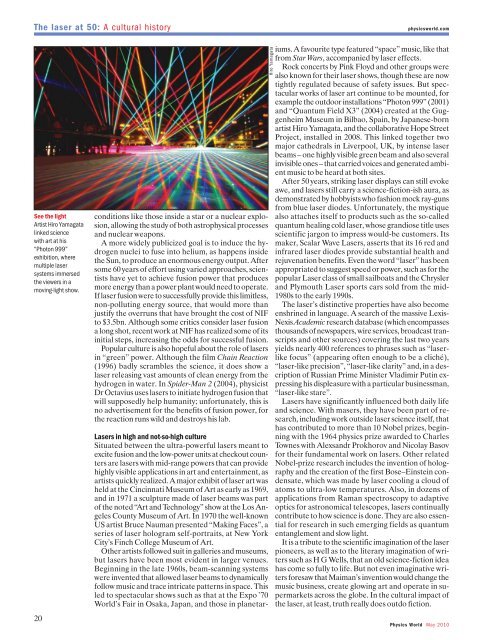special issue
special issue
special issue
You also want an ePaper? Increase the reach of your titles
YUMPU automatically turns print PDFs into web optimized ePapers that Google loves.
The laser at 50: A cultural historyphysicsworld.comSee the lightArtist Hiro Yamagatalinked sciencewith art at his“Photon 999”exhibition, wheremultiple lasersystems immersedthe viewers in amoving-light show.20conditions like those inside a star or a nuclear ex plo -sion, allowing the study of both astrophysical processesand nuclear weapons.A more widely publicized goal is to induce the hy -drogen nuclei to fuse into helium, as happens insidethe Sun, to produce an enormous energy output. Aftersome 60 years of effort using varied approaches, scientistshave yet to achieve fusion power that producesmore energy than a power plant would need to operate.If laser fusion were to successfully provide this limitless,non-polluting energy source, that would more thanjustify the overruns that have brought the cost of NIFto $3.5bn. Although some critics consider laser fusiona long shot, recent work at NIF has realized some of itsinitial steps, increasing the odds for successful fusion.Popular culture is also hopeful about the role of lasersin “green” power. Although the film Chain Reaction(1996) badly scrambles the science, it does show alaser releasing vast amounts of clean energy from thehydrogen in water. In Spider-Man 2 (2004), physicistDr Octavius uses lasers to initiate hydrogen fusion thatwill supposedly help humanity; unfortunately, this isno advertisement for the benefits of fusion power, forthe reaction runs wild and destroys his lab.Lasers in high and not-so-high cultureSituated between the ultra-powerful lasers meant toexcite fusion and the low-power units at checkout countersare lasers with mid-range powers that can providehighly visible applications in art and entertainment, asartists quickly realized. A major exhibit of laser art washeld at the Cincinnati Museum of Art as early as 1969,and in 1971 a sculpture made of laser beams was partof the noted “Art and Technology” show at the Los An -geles County Museum of Art. In 1970 the well-knownUS artist Bruce Nauman presented “Making Faces”, aseries of laser hologram self-portraits, at New YorkCity’s Finch College Museum of Art.Other artists followed suit in galleries and museums,but lasers have been most evident in larger venues.Beginning in the late 1960s, beam-scanning systemswere invented that allowed laser beams to dynamicallyfollow music and trace intricate patterns in space. Thisled to spectacular shows such as that at the Expo ’70World’s Fair in Osaka, Japan, and those in planetar -Hiro Yamagataiums. A favourite type featured “space” music, like thatfrom Star Wars, accompanied by laser effects.Rock concerts by Pink Floyd and other groups werealso known for their laser shows, though these are nowtightly regulated because of safety <strong>issue</strong>s. But spec -tacular works of laser art continue to be mounted, forexample the outdoor installations “Photon 999” (2001)and “Quantum Field X3” (2004) created at the Gug -gen heim Museum in Bilbao, Spain, by Japanese-bornartist Hiro Yamagata, and the collaborative Hope StreetProject, installed in 2008. This linked together twomajor cathedrals in Liverpool, UK, by intense laserbeams – one highly visible green beam and also severalinvisible ones – that carried voices and generated ambientmusic to be heard at both sites.After 50 years, striking laser displays can still evokeawe, and lasers still carry a science-fiction-ish aura, asdemonstrated by hobbyists who fashion mock ray-gunsfrom blue laser diodes. Unfortunately, the mystiquealso attaches itself to products such as the so-calledquantum healing cold laser, whose grandiose title usesscientific jargon to impress would-be customers. Itsmaker, Scalar Wave Lasers, asserts that its 16 red andinfrared laser diodes provide substantial health andrejuvenation benefits. Even the word “laser” has beenappropriated to suggest speed or power, such as for thepopular Laser class of small sailboats and the Chryslerand Plymouth Laser sports cars sold from the mid-1980s to the early 1990s.The laser’s distinctive properties have also becomeenshrined in language. A search of the massive Lexis -Nexis Academic research database (which encompassesthousands of newspapers, wire services, broadcast transcriptsand other sources) covering the last two yearsyields nearly 400 references to phrases such as “laserlikefocus” (appearing often enough to be a cliché),“laser-like precision”, “laser-like clarity” and, in a des -cription of Rus sian Prime Minister Vladimir Putin ex -pressing his displeasure with a particular businessman,“laser-like stare”.Lasers have significantly influenced both daily lifeand science. With masers, they have been part of re -search, including work outside laser science itself, thathas contributed to more than 10 Nobel prizes, beginningwith the 1964 physics prize awarded to CharlesTownes with Alex sandr Prokhorov and Nicolay Basovfor their fundamental work on lasers. Other relatedNobel-prize research includes the invention of holographyand the creation of the first Bose– Einstein condensate,which was made by laser cooling a cloud ofatoms to ultra-low temperatures. Also, in dozens ofapplications from Raman spectro scopy to adaptiveoptics for astronomical telescopes, lasers continuallycontribute to how science is done. They are also essentialfor research in such emerging fields as quantumentanglement and slow light.It is a tribute to the scientific imagination of the laserpioneers, as well as to the literary imagination of wri -ters such as H G Wells, that an old science-fiction ideahas come so fully to life. But not even imaginative wri -ters foresaw that Maiman’s invention would change themusic business, create glowing art and operate in su -per markets across the globe. In the cultural impact ofthe laser, at least, truth really does outdo fiction.Physics World May 2010



